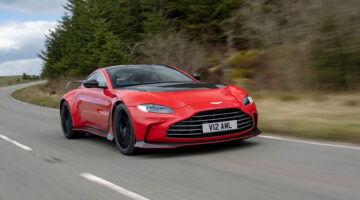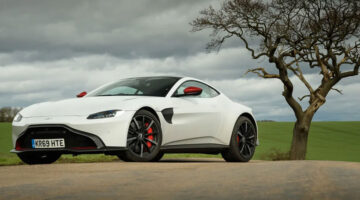Everything has changed now. Aston Martin’s introduction of the new V8 Vantage is going to have more than a few companies worried.
The last time I drove an Aston Martin Vantage was in 2007. Back then it was the V8 Roadster (it was for a GT comparison test) and it was… fine. The gearbox was a first generation sequential, single clutch, the interior was nice and the keys were, well, Ford in origin. That was the biggest letdown for me at the time – having owned a Ford Fiesta myself, finding the same exact key igniting an Aston Martin was something of an anticlimax.
The engine, though, was outright fantastic and I vividly recall passing through a tunnel several times just to enjoy the throaty rumble of those eight pistons rhythmically bouncing off the walls and into my ears, unencumbered by roof or windows. It was glorious.
The V8 Vantage was the least expensive model Aston Martin had in the line-up and, over the course of its 12-year production run, it went on to sell more than 20,000 units. For a marque that ships fewer than 4,500 cars per year, the Vantage, then, was an enormous success story.
However, the Vantage always seemed to lack a certain edge, a personality if its own. The heavy metal soundtrack produced by its V8 was unique but there was little else to mark it out as different to the rest of the Aston line-up. It was a more compact DB9, a diminutive Rapide; a car that detractors viewed as being bought only by those who could not afford one of the more desirable and costlier models. In looks, feel and performance, it simply came across as less in every respect than the others and its replacement needed to address that, if Aston Martin was to become a profitable entity.
And this new model really is a different story. Introduced in 2017 (although deliveries are just starting now), the Vantage is a true sports car. No longer the baby Aston, but a pure driving machine designed to spike the hairs of the back of your neck just by looking at it.
And how they managed to do it was very simple. Perhaps some engineers at other German companies near the Stuttgart area may learn from them. They took a blank sheet of paper, defined the core characteristics and started the design from near zero. They dismissed most of what they had done before, and kept just some minor details that are staples of the Aston Martin brand, and it shows.
From the outside, the Vantage immediately indicates its focus. It’s menacing from the front, the headlights are thin and slanted in a frown, and the hump on the bonnet acts as a creased brow that accentuates the anger. A little lower, the traditional Aston Martin shaped front grille is enormous and seemingly not integrated with the body. The effect is as the big mouth of a sprinter, or the voice box of a storm trooper. It’s so intimidating that if Darth Vader had modeled his helmet on the front of this car it would not be out of place.
The side profile is muscular and lean, with a continuous curving shape that starts at the nose, follows the doors and drops towards the rear. Between the wheels there is another line that mimics the wing of a plane. It seems to indicate that they tried to create a ‘Venturi’ effect on the floor of the car. Between the front and rear tyres, the floor of the car extends laterally beyond the natural flow of the body, accentuating its aerodynamic features. The side gills, another Aston tradition, this time serve to enhance airflow from the front tyres to reduce lift and increase flow towards the sides of the car. Mark my words, every design detail with the new Vantage serves a distinct purpose and it looks terrific, even when painted in lurid green.
To reduce the overall height of the car, lower the centre of gravity and improve balance, the Vantage has its engine mounted behind the front axle. As such, the wheels are pushed to the edge of the car and, while the overall length is 4.46 metres, the wheelbase is long at 2.7 metres.
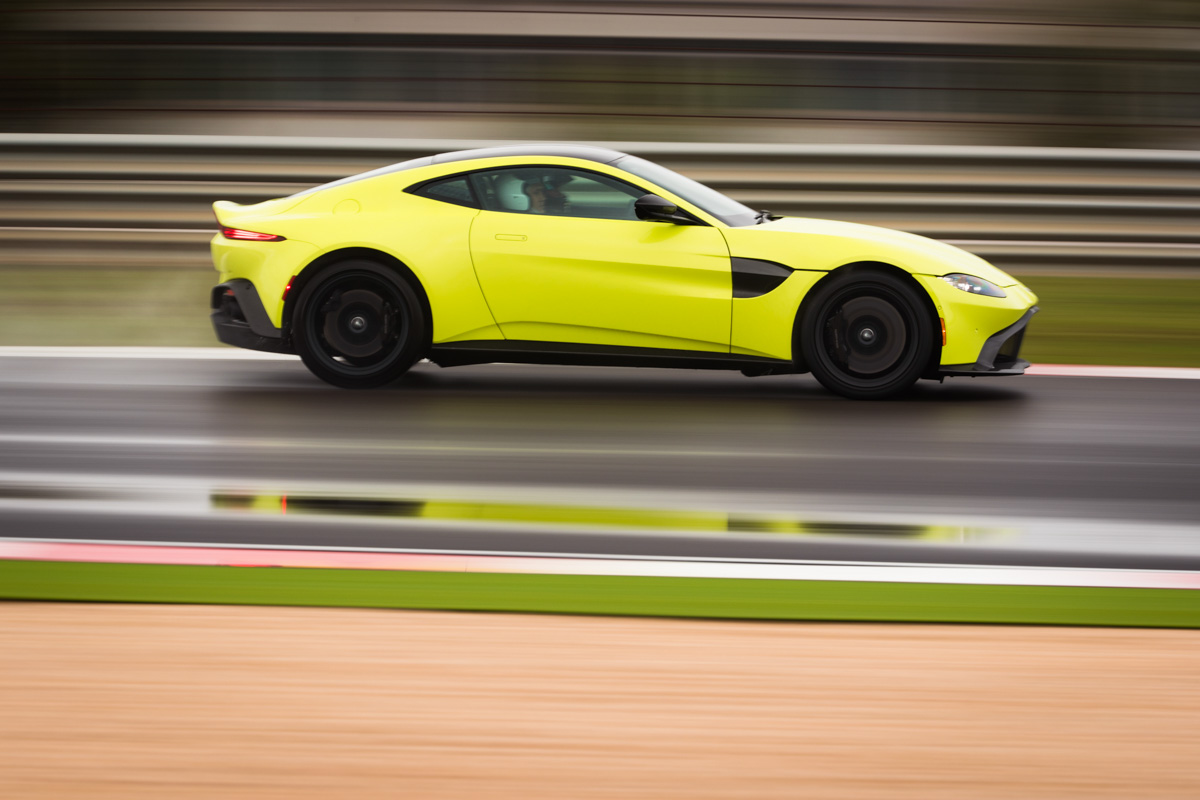
And the rear is, if that’s even possible, angrier looking than the front. The enormous air diffuser which, like the grill, seems disconnected from the body, is so large it seems to interfere with the natural shape. Then the thin LED light strip outlining the traditional Aston shape combines with the diffuser to give a very clear message: “Don’t mess with me”. Don’t worry, I won’t.
The philosophy continues throughout the interior, where the designers have managed to pack a ton of settings into as little as 35 buttons in total, including the starter. The instrument panel is completely digital, allowing a variety of configurations and colours. The cooperation with Mercedes starts to show in the infotainment system and its control. You could say that a larger screen would not go amiss on a 2018 car, as the equipped 8-inch display is slightly small if, like me, you’ve forgotten your glasses, but really that’s nitpicking.
The Bang and Olufsen audio system fitted to the new Vantage is perfectly competent, easily connecting Bluetooth, iPhone, Android and Satellite Navigation, and it sounds just fine, though in all fairness, the car is so noisy this is mostly irrelevant. And the source of the noise sits right in front of the driver. The 4.0-litre, twin-turbo V8 that powers the AMG cars, tuned to 503bhp at 6,000rpm and 685Nm from 2,000-5,000rpm elicits three, very important, thoughts:
First, the commitment from Aston Martin to the future by leaving outdated aspiration technology and embracing turbo. Yes, I am sure that some will miss the ‘traditional Aston Martin sound’ but as stated from the beginning, the personality of the Vantage is clearly defined towards making it a true sports car. If you feel you need the ‘purity’ of tradition, go ahead and buy a Morgan. In this case, modern is better.
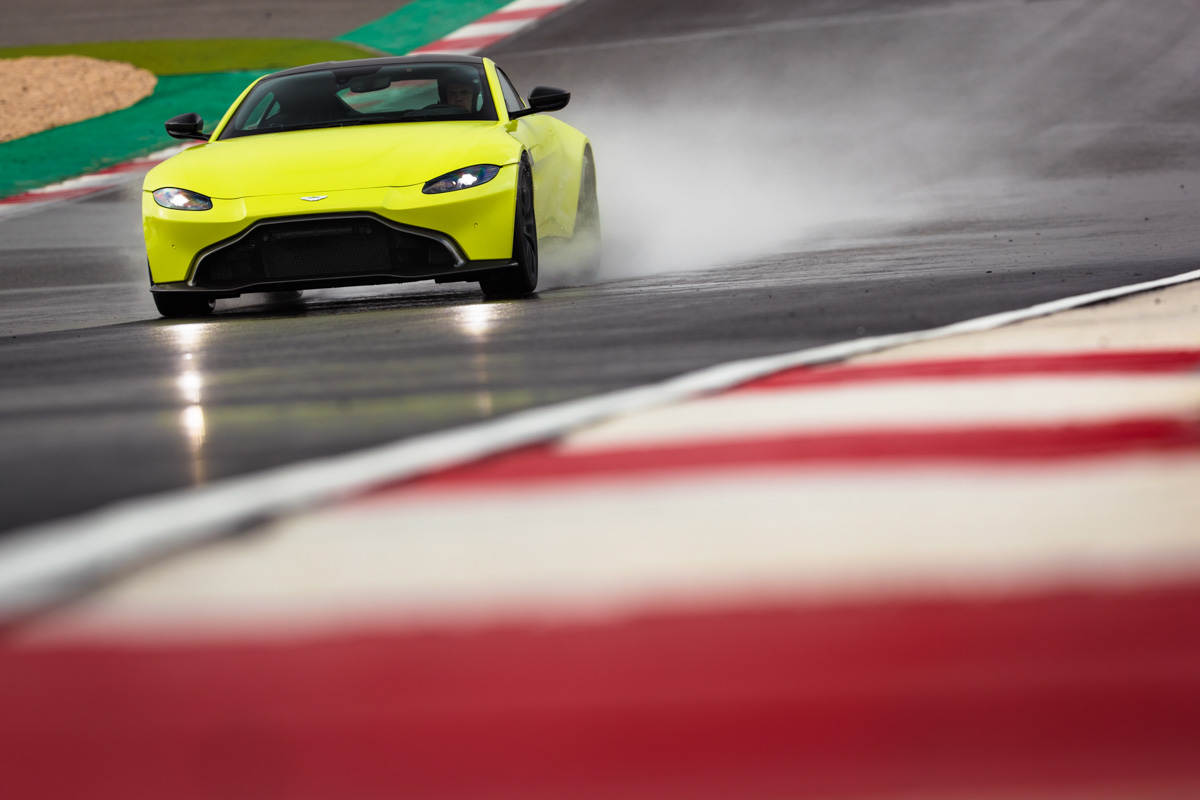
Second, we know that this engine can produce over 600bhp in the Mercedes E63 AMG. That means Aston has, finally, a product life plan. Combine this with the abundance of heavy interior luxury items, and the next seven years will no doubt reveal a few more versions with increased power and reduced weight.
And third, the engineers at Aston could not leave tradition completely behind, so the engine bay has been designed to hold the V12 engine available in the DB11. I personally hope they don’t go that route as the Mercedes engine’s capabilities are quite enough but, if there’s sufficient demand for it, the space is there.
On the track, which happens to be the Portimao International Circuit in Portugal, I’m immediately able to attest just how well put together everything is on the new Vantage. Aston has shifted the three driving modes to Sport, Sport+ and Track, leaving Comfort for the wimps. And rather than being a clever marketing ploy, where they would just name things differently, the Sport mode really is just that – throttle response is immediate and the power delivery is ridiculously linear.
A track is not a road and sharp direction changes are the norm. And it’s here we find that the rack mounted paddle shifters are quite inconvenient during sharp cornering. Perhaps a wheel-mounted system, which moves as you turn it, would be better and allow for neater, even faster gear changes.
The steering is weighty, fast and precise and, for someone with the proper driving skills, hitting the apex should be an easy task. The aluminum chassis, which is 70 per cent new, offers a rigidity of 42,000 Newton per degree. That is a good jump from the DB11’s 32,000, and from the previous version’s 27,000. This means the chassis is like a rock. For comparison purposes, a Lamborghini Aventador is about 35,000.
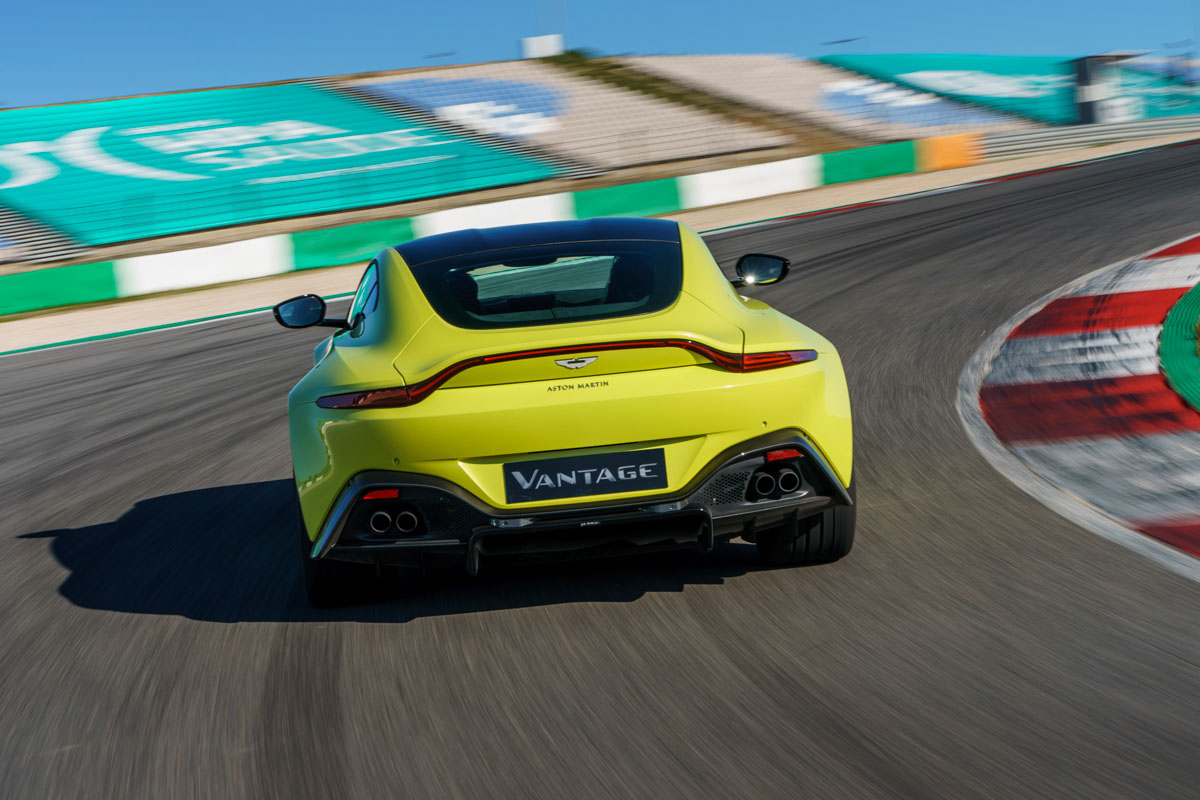
Now, these extremely nerdy figures do have a purpose when you consider how much power a chassis can take. Upgrading gearboxes, engines, turbos and prop-shafts is relatively easy. Hardening a chassis is tough and the extra margins available here speak volumes about the proposed life plan for this model over the coming years, and the power upgrades it will be able to handle.
Upshifting the ZF 8-speed gearbox is fast enough to catapult the Vantage to 100kph from rest in 3.6 seconds but do not be fooled by the numbers alone, as the amount of driving dynamics electronics built in are the ones that make the difference. In particular, the dynamic torque vectoring, which ensures maximum power to each wheel, adaptive damping, which enhances the downward force, and an electronic limited slip differential, which is linked to the driving computer and can lock the differential in milliseconds.
As such, cornering speed and lateral G are outstanding, and for a normal person to handle the car on the edge is now, not only accessible, but is easy and safe. Additionally, the driving modes and traction controls do allow a certain controlled tolerance that makes you feel so talented you start believing you should have been a professional racing driver.
Lest we forget, sometimes, after gaining speed quickly, you need to stop and, in my opinion, the best brakes are those you don’t need to talk about. That’s the case on this car – the brakes are just there, doing what they are supposed to do, all of the time.
On the scales it checks in at 1530kg completely dry. This is Porsche 911 Turbo territory and a clear indication of whom it targets. Weight balance is a perfect 50:50 and the power is transferred to the ground through a set of specifically Vantage tuned Pirelli P Zero tyres – 255/40 up front and 295/35 at the back. Pricey? Yes. Good? Oh dear me, YES!
For those engineers out there we should mention that the suspension is a forged double wishbone at the front and a multilink behind. Unlike the DB11, the rear suspension is solidly mounted into the chassis, making the connection with the driver all the more direct and informative. This does translate into a rougher ride but one that, rather than diminish the car’s character, actually enhances it.
For our road test, the weather gods decided that we should try driving a 503bhp sports car in the pouring rain. After a dry, sunny day on track, it seems fair and the winding wet roads of southern Portugal demonstrate that my impressions from the day before translate perfectly to everyday life.
Normal cruising speeds on the highway and in town are smoother than the sporty setup would have you anticipating, and while it poured, the amount of available grip is surprisingly high. Also, the sound in the cabin is rumbly but not unpleasant and, while this is obviously the right transport for a family holiday, the 350km covered on this incredible road route go by in total bliss.
The Vantage comes equipped with the raft of driving aids we have grown accustomed to in new luxury cars, such as blind-spot and parking sensors, cruise control and all the rest. And many of these aids could be considered essential here, as the car is quite low on ground clearance, and those carbon fibre inserts can break quite easily against a kerb. And they are not what you’d call cheap to replace, either.
In conclusion, the new Aston Martin Vantage is truly a great sports car. At just over $160K it is slightly more expensive in comparison to, say, a 911 GT3 but I would argue that it will put a smile on your face every day of the week, and in terms of boot space when going to the shops, the 350-litres provided by the Aston gives it a clear practical edge.
On the road and the track I can think of hardly anything that is more fun or that gives such a sense of total control and balance. Aesthetically it is one of the most beautiful cars on the market and, on the exclusivity ranks, don’t forget that Aston Martin shifted a total of just 4,200 units last year, so the chances of seeing another one on the road are slim.
I want one. For the fist time in my life, I really want an Aston Martin – the V8 Vantage has finally come of age and made good on all those early promises.
Photography by Max Earey and Dominic Fraser
| Aston Martin | Vantage |
|---|---|
| Engine: | V8, 3982cc, twin-turbo |
| Power: | 503bhp @ 6000rpm |
| Torque: | 505lb ft @ 2000-5000rpm |
| Transmission: | 8-speed semi-automatic |
| Front suspension: | double wishbones, coil springs anti roll bar |
| Rear suspension: | Multi-link, coil springs, anti-roll bar |
| Brakes: | 400mm discs (front), 360mm discs (rear) |
| Wheels: | 20-inch alloy front and rear |
| Tyres: | 255/40R20 front, 295/35R20 rear |
| Weight (kerb) | 1530kg |
| Power-to-weight | 334bhp/ton |
| 0-100kph: | 3.6sec (claimed) |
| Top speed: | 314kph (claimed) |
| Basic Price: | $167,000 |

